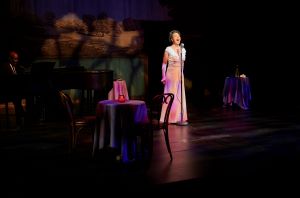There is no question that director Miloš Forman‘s 1984 motion picture adaptation of Peter Shaffer‘s play about Antonio Salieri and Wolfgang Amadeus Mozart, entitled Amadeus, is a great film. Among other honors, it was awarded eight Oscars, including “Best Film” and “Best Performance by an Actor in a Leading Role” (F. Murray Abraham in the role of Salieri). Tom Hulce‘s portrayal of Mozart was also nominated for that award.
There is also no question that Shaffer’s characterization of Mozart as a vulgar libertine with a high-pitched silly laugh has no historic evidence, no more that the depiction of Salieri as Mozart’s amanuensis on his deathbed. But such things can be left to film critics; it’s the glorious music of Mozart, omnipresent in the film, enlivened in the NC Symphony and NC Master Chorale‘s collaborative performance at Meymandi Hall, which is our topic.
The minimalistic program did not name the instrumental performers, enumerating only the 59 singers from Alfred E. Sturgis‘ NC Master Chorale; the orchestra was properly of Mozartean size, all conducted by film-music specialist (and composer) John Jesensky. While his conducting style at times resembled a marionette-on-strings (his head unmoving, his shoulders moving up and down), he did a superb job in synchronizing the “live” musicians’ playing with the 34-year-old film which was projected, with clear subtitles of the spoken English dialogue, on a huge screen stretching high above the stage. As noted by another audience member, “no problems with sight-lines in THIS theater!”
Keeping the two media “in synch” is no easy matter, especially when the film depicts Salieri leafing through a number of Mozart’s manuscript scores and hearing them in his head; the orchestra has to change from one score to another with almost no break, and dare not get behind the action. The result was so good that, for the most part, one could forget that the music wasn’t the original film score (originally played by the Academy of St. Martin in the Fields). The NC Symphony and Chorale members joined their efforts with the visual elements to produce a finely-unified work of art.
A wide range of Mozart’s music was heard, from the opening Overture to the opera Don Giovanni to the closing strains of the “Romanze” from the Piano Concerto No. 20, in D minor. The chorus was especially effective in their singing of the Kyrie from the Mass in C minor and in the excerpts from the Requiem, even if the dotted-eighth-and-sixteenth-note passages of “Confutatis maledictis” often sounded more like triplets.
In his all-too-short life, Mozart composed operas, symphonies, concerti, chamber music, masses, and other music which still lives today. Amadeus reminds us of the variety and the glories of this “beloved of God” (“Amadeus”) composer. The film came alive today with Mozart’s music performed anew, for which audiences may be grateful. We thank the North Carolina Symphony and Master Chorale for making it happen.
This performance repeats Friday, June 8. See our sidebar for details.











